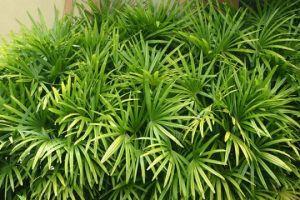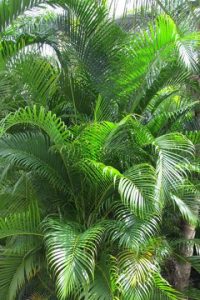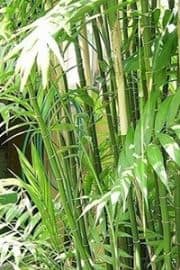Family traits make everyone in the same bloodline have many similarities, but all members retain their own identity while displaying common features. The palm family has more than 2700 species, making it a highly versatile type of plant to include in your landscape. With a wide range of shapes and sizes, palms have the desirable attributes of a landscape plant that you prefer. Some of them may surprise you with their elegance and beauty.
Creating a Tropical Paradise
Small palms that grow to a maximum height of 20 feet put their color, texture and shape where you can see them. Many palms in south Florida reach a height that approaches 100 feet. While they may appear stately from a distance, they present only a view of a trunk when you see them in your yard. Maintenance often includes trimming dead fronds, and reaching the top of large palms requires professional assistance. For elegance, ease of care and an authentic Florida accent, consider these palms for use in your tropical paradise:
Lady Palm
 Praise for the beauty of the rhapis excelsa includes admiration for its layered appearance and the architectural shape of its thin trunks and lush leaves. The lady palm grows in clumps and reaches a maximum height of about 10 feet, making it an ideal plant to use as a specimen in a featured area of your yard.
Praise for the beauty of the rhapis excelsa includes admiration for its layered appearance and the architectural shape of its thin trunks and lush leaves. The lady palm grows in clumps and reaches a maximum height of about 10 feet, making it an ideal plant to use as a specimen in a featured area of your yard.
New growth emerges from underground runners, but you can trim it with your lopping shears to manage the plant’s shape. Full sun is usually too hot for its deep green leaves, and it thrives in an area that has partial sun or full shade. Hardy and beautiful all year, the rhapis (pronounced ray-fis) palm in your yard identifies you as a knowledgeable landscape gardener.
Areca
 Sometimes called a “butterfly palm”, the areca adapts well to corner locations as an accent plant, as a cover for a blank wall, as a privacy hedge or as a feature in your lanai. The clustering plant is wider at the top than at the bottom, and it may reach a width of 10 feet. At a maximum height of 15 or 20 feet, it can provide a canopy of shade for smaller plants.
Sometimes called a “butterfly palm”, the areca adapts well to corner locations as an accent plant, as a cover for a blank wall, as a privacy hedge or as a feature in your lanai. The clustering plant is wider at the top than at the bottom, and it may reach a width of 10 feet. At a maximum height of 15 or 20 feet, it can provide a canopy of shade for smaller plants.
The areca has a desirable ability to clean itself by dropping occasional fronds that turn brown, a process that helps promote the health of the plant. Trimming them with your shears is an option that you may prefer.
Applying fertilizer three times a year helps the palm produce luscious greenery for your paradise. The slow growing palm grows well in sun or shade.
 Bamboo
Bamboo
Presenting growth at various heights up to 10 feet, the bamboo palm mimics its namesake while displaying recognizable features of its family. Clustering and sending new shoots from its base, the plant presents dense foliage that flourishes under the shade of larger plants. Its reputation as an “understory” palm confirms that you can plant it in an established garden area where it thrives on shade and moisture. Ability to tolerate filtered light makes it an excellent indoor plant as well, as long as you place it away from your air conditioning vents.
Loving shade, the bamboo palm contributes classic beauty to a garden area that includes ferns, peace lilies, ginger, alocasia and numerous other plants that require a similar environment. For hedges or screens, the slow growing palm transplants eventually grow together, making it acceptable to plant them close or at spaced intervals. Placing them around the base of trees covers root buttresses and provides a soft contrast to rough trunks.
R & R Sprinkler & Landscape
931 SE 11th Avenue
Cape Coral, FL 33990
(239) 772-2607


